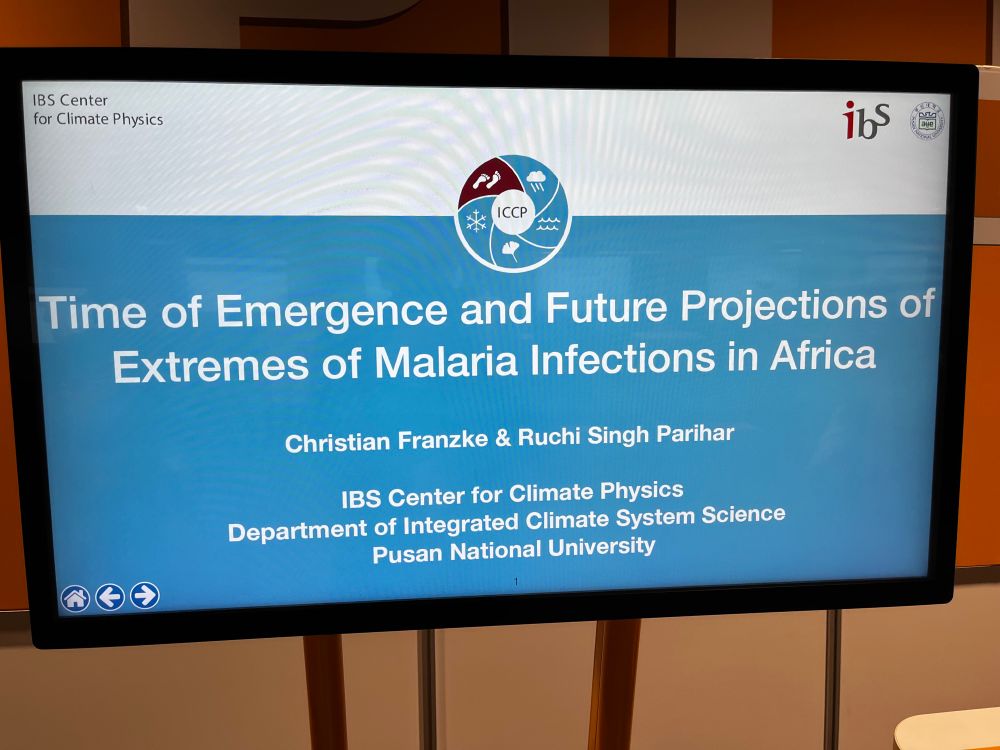https://climatelaboratory.wordpress.com/
Based on global km-scale coupled climate model simulation we just published in Earth System Dynamics:
Earth's future climate and its variability simulated at 9 km global resolution
#openaccess
esd.copernicus.org/articles/16/...

Based on global km-scale coupled climate model simulation we just published in Earth System Dynamics:
Earth's future climate and its variability simulated at 9 km global resolution
#openaccess
esd.copernicus.org/articles/16/...
Just out: Timing of the Recent Migration and Intensification of the Southern Hemisphere Westerly Winds in GRL @agu.org with colleagues from @bas.ac.uk and Cambridge University
agupubs.onlinelibrary.wiley.com/doi/10.1029/...
#openaccess

Just out: Timing of the Recent Migration and Intensification of the Southern Hemisphere Westerly Winds in GRL @agu.org with colleagues from @bas.ac.uk and Cambridge University
agupubs.onlinelibrary.wiley.com/doi/10.1029/...
#openaccess
Fresh from the press: Out new paper on #malaria in #Africa, Time of Emergence and #extremes
Read here: agupubs.onlinelibrary.wiley.com/doi/10.1029/...
#openaccess

Fresh from the press: Out new paper on #malaria in #Africa, Time of Emergence and #extremes
Read here: agupubs.onlinelibrary.wiley.com/doi/10.1029/...
#openaccess
🧪 #science #research
www.science.org/doi/10.1126/...

🧪 #science #research
www.science.org/doi/10.1126/...
Just out our new paper in Nature Communications on preferred propagating terrestrial heatwave pathways due to Rossby wave activity
#openaccess
www.nature.com/articles/s41...

Just out our new paper in Nature Communications on preferred propagating terrestrial heatwave pathways due to Rossby wave activity
#openaccess
www.nature.com/articles/s41...
So far attended sessions on wildfires and also health impacts today
I am positively surprised how many health sessions are at EGU
So far attended sessions on wildfires and also health impacts today
I am positively surprised how many health sessions are at EGU
I start with a session on climate and health ITS2.4 PICO spot 2
Here we argue for more research into integrated modeling frameworks, understanding and modeling of transmission pathways and systemic climate risk governance approaches.
#openaccess
🧪
Read for yourself: journals.plos.org/climate/arti...

Here we argue for more research into integrated modeling frameworks, understanding and modeling of transmission pathways and systemic climate risk governance approaches.
#openaccess
🧪
Read for yourself: journals.plos.org/climate/arti...
👉 Discover more here: egu.eu/5GIESL/

👉 Discover more here: egu.eu/5GIESL/
We show that the strongest anthropogenic trends in biomass burning are in southern and central equatorial Africa, Madagascar, Australia, parts of the Mediterranean and western North-America.
🧪
We show that the strongest anthropogenic trends in biomass burning are in southern and central equatorial Africa, Madagascar, Australia, parts of the Mediterranean and western North-America.
🧪
🧪
#openaccess
agupubs.onlinelibrary.wiley.com/doi/10.1029/...

🧪
#openaccess
agupubs.onlinelibrary.wiley.com/doi/10.1029/...
Even if the manuscripts are rejected the reviewer reports are publicly available.
theconversation.com/fake-papers-...

Even if the manuscripts are rejected the reviewer reports are publicly available.
theconversation.com/fake-papers-...
There are also opportunities to get involved in other ongoing projects at ICCP
Please contact me if you are interested
ibsclimate.org/jobs/postdoc...
There are also opportunities to get involved in other ongoing projects at ICCP
Please contact me if you are interested
ibsclimate.org/jobs/postdoc...
First sunrise of the new year from Yunsan mountain

First sunrise of the new year from Yunsan mountain


www.frontiersin.org/journals/cli...
#openaccess

www.frontiersin.org/journals/cli...
#openaccess
It was my pleasure to chair his PhD committee

It was my pleasure to chair his PhD committee
🎓 The University of Trento, jointly with CNR-ISAC, is seeking 2 candidates to work on the new project MedHEX.
🗓️ Open until: 12 pm on 14/02/2025
🗓️ Contract length: 15 months
💲 Gross annual salary: Euros 29.550,00
👉 Apply here: lavoraconnoi.unitn.it/en/research-...
🎓 The University of Trento, jointly with CNR-ISAC, is seeking 2 candidates to work on the new project MedHEX.
🗓️ Open until: 12 pm on 14/02/2025
🗓️ Contract length: 15 months
💲 Gross annual salary: Euros 29.550,00
👉 Apply here: lavoraconnoi.unitn.it/en/research-...
we are organizing a session on "Understanding and Modeling of Weather and Geophysical Extremes and Related Complex Risks" at the BACO-25 meeting in Busan next year 20-25 July 2025
baco-25.org/new/
we are organizing a session on "Understanding and Modeling of Weather and Geophysical Extremes and Related Complex Risks" at the BACO-25 meeting in Busan next year 20-25 July 2025
baco-25.org/new/
Led by @valeriolembo.bsky.social we published a paper on Rossby waves #heatwaves and compound #extremes based on a nice workshop a year ago
journals.ametsoc.org/view/journal...
#openaccess
Today I am giving last lecture of my class Climate Crisis and Societal Impacts in PNU’s general education program
It was fun teaching a wide variety of undergraduate students about climate and impacts
Today I am giving last lecture of my class Climate Crisis and Societal Impacts in PNU’s general education program
It was fun teaching a wide variety of undergraduate students about climate and impacts
Led by @valeriolembo.bsky.social we published a paper on Rossby waves #heatwaves and compound #extremes based on a nice workshop a year ago
journals.ametsoc.org/view/journal...
#openaccess
Led by @valeriolembo.bsky.social we published a paper on Rossby waves #heatwaves and compound #extremes based on a nice workshop a year ago
journals.ametsoc.org/view/journal...
#openaccess


